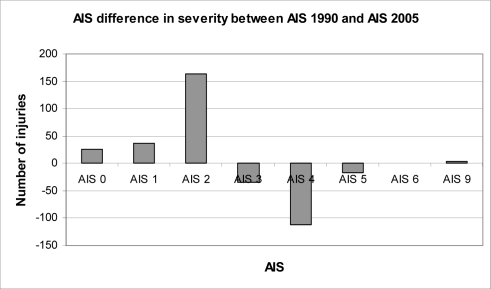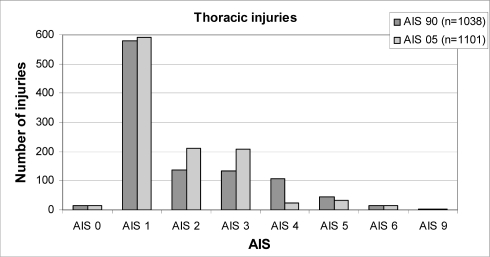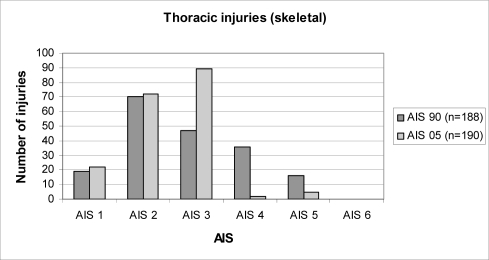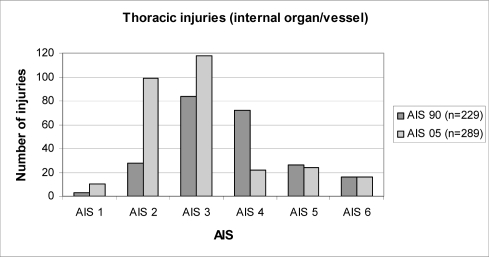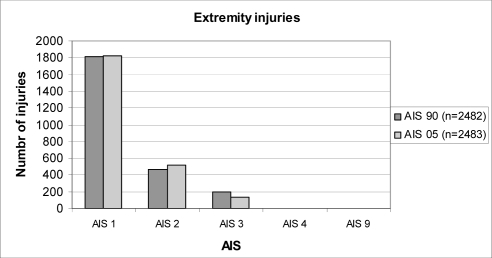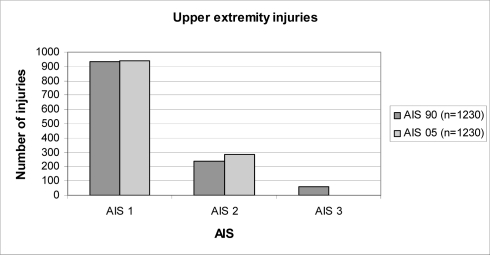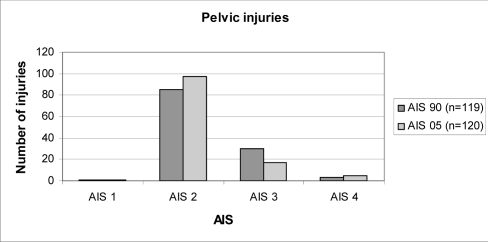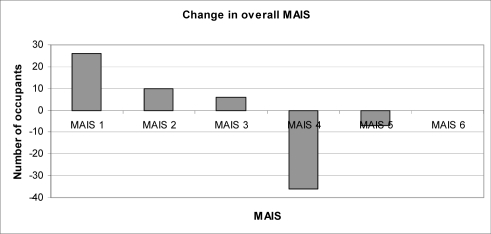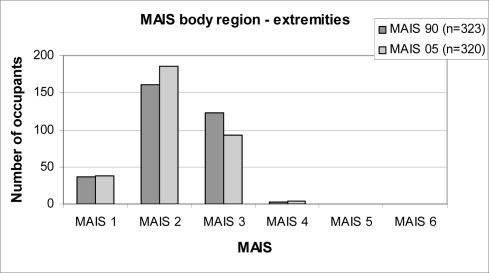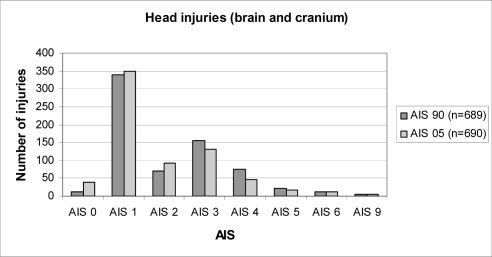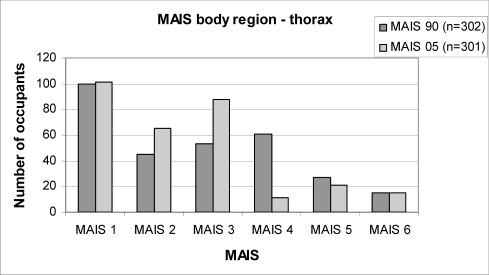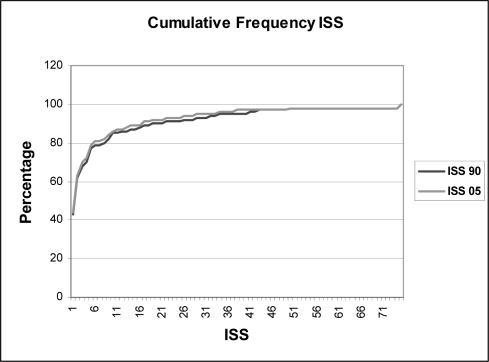Abstract
The aim of this study is to investigate the differences in car occupant injury severity recorded in AIS 2005 compared to AIS 1990 and to outline the likely effects on future data analysis findings. Occupant injury data in the UK Cooperative Crash Injury Study Database (CCIS) were coded for the period February 2006 to November 2007 using both AIS 1990 and AIS 2005.
Data for 1,994 occupants with over 6000 coded injuries were reviewed at the AIS and MAIS level of severities and body regions to determine changes between the two coding methodologies.
Overall there was an apparent general trend for fewer injuries to be coded at the AIS 4+ severity and more injuries to be coded at the AIS 2 severity. When these injury trends were reviewed in more detail it was found that the body regions which contributed the most to these changes in severity were the head, thorax and extremities.
This is one of the first studies to examine the implications for large databases when changing to an updated method for coding injuries.
INTRODUCTION
The UK’s Co-operative Crash Injury Study (CCIS) is one of Europe’s largest car occupant injury causation studies (www.ukccis.org). The longevity of the study demands that it is relevant to what is occurring in the ‘real world’ for vehicle technology and also medically. Thus there is a need to ensure that revisions in data collection methods are understood, compatible and do not have an effect on the usability of the data over time.
Since the inception of CCIS all injuries sustained in the accidents have been coded to allow for their use in data analysis. The injuries are coded and always have been according to the Abbreviated Injury Scale (AAAM). The Abbreviated Injury Scale (AIS) dictionary itself has been used for thirty years since the first edition was introduced in 1976 [AAAM 1976], although it was originally published in 1971. The AIS is an ordinal scale which is used to rank the severity of injuries from 1 to 6, (Minor through to Currently Untreatable). It describes injuries anatomically and judges the threat to life based on each single injury occurring in a healthy adult. The AIS has continued to evolve with each dictionary publication; the original dictionary consisted of a list of 500 injuries which were then expanded upon in 1980 and 1985 providing users with better injury descriptors [AAAM 1985]. By 1990 the dictionary had undergone a major overhaul to include 1,331 injury descriptors with more refined choices to address child injuries [AAAM 1990]. This version of the dictionary also included guidelines for coders to promote uniformity in injury coding across the globe. Although there was an update in 1998 of the dictionary this did not introduce major changes [AAAM 1998]. The recent introduction of the AIS 2005 dictionary has expanded the contents to 2,104 injury descriptors [AAAM 2007]. This has resulted in an expanded list of injuries in an attempt to incorporate all trauma. This new data dictionary reflects injuries that occur in different circumstances (e.g. road crashes, explosions). The new scale is reflective of advances in medical interventions and is designed to be compatible with other injury scaling systems. One major aim of the AIS 2005 update was to improve the specificity of certain injuries to reflect more accurately modern treatments and technology. The extremity chapters have undergone the severest revisions mainly for fractures to enhance the specificity of injuries as to their location (i.e. proximal, shaft, distal) and joint involvement which would have an effect on functional outcome. The most noticeable change in the head chapter is the removal of the concussive injury section and its reliance on loss of consciousness to diagnose some injuries. Thus specific concussion injury codes have been developed as well as an in-depth section on diffuse axonal injury which is aimed to encourage accurate coding of these injuries. Other changes in the brain are the introduction of ‘tiny’ as a descriptor with a lower severity compared to ‘small’ as a descriptor for such injuries as brain contusions. Changes to the thorax chapter included rule changes to allow for coding of injuries separately rather than for coexisting injuries, for example in AIS 1990 rib fracture with haemo/pneumothorax would be assigned one code and one severity whereas in AIS 2005 two codes and potentially two different severities will be recorded. The other main revision is the inclusion of more specific ‘bilateral’ injury codes which are considered to be more serious injuries and potentially are assigned a higher severity than a unilateral injury. Other revisions have occurred in other chapters to include a new injury descriptor or amend the severity of certain injuries. A concise description of the changes can be found in Gennarelli and Wodzin [2006] and the AIS 2005 update dictionary [2008].
For any database a change at any level has to be reviewed particularly where the change can have a direct impact on the results from old and new data. The aim of this study is to review the changes between the ‘old’ AIS 1990 and the ‘new’ AIS 2005 data dictionaries on a large dataset to determine what likely effects a new coding methodology has on injury severity for future data analysis. There is an expectation that head injuries may be less severe in AIS 2005 with the introduction of ‘tiny’ brain contusions at AIS 2 severity and the reduction in severity of loss of consciousness to an AIS 1 from AIS 2.
METHODS
In-depth crash injury data from the UK Co-operative Crash Injury Study (CCIS) were used to explore the study objectives. The CCIS study uses multi-disciplinary teams to examine crashed vehicles and correlate vehicle damage with the injuries sustained to determine how car occupants are injured. The main objective of the CCIS study is to improve vehicle safety performance by continuing to develop a scientific knowledge base, which can be used to identify the future priorities for vehicle safety design as technology develops. CCIS selects cases for investigation using a stratified sampling procedure based on car occupants’ injury severity, with a weighting and hence a bias towards fatal and seriously injured casualties. Cases were selected from the CCIS database from February 2006 to November 2007. All injuries were coded to AIS 1990 and AIS 2005 from medical notes or post mortem reports where appropriate. AAAM trained coders were used to code all injuries. Detailed injury information was available for each occupant in the study including the AIS, maximum AIS (MAIS) by body region and Injury Severity Score (ISS).
The data were analysed to review the changes between the two coding methodologies (AIS 1990 and AIS 2005) for the overall AIS and MAIS severity and body region AIS and MAIS severity and ISS. The percentage differences in the injuries for each coding methodology were used to highlight the changes in AIS severity between AIS 1990 and AIS 2005. Statistical significance between the two AIS methodologies was determined using non-parametric statistics (Wilcoxon rank sum test for pairs and, Kendals tau) with significance determined at the p<0.05. This analysis examines all occupants who were involved in a road traffic crash during the study period. Not all occupants were injured and not all injuries were known.
The assessment of multiple injuries is an important area to consider when analysing crash data as it is likely that two or more injuries occur as opposed to single isolated injuries. The methods used for assessing occupants with multiple injuries are the MAIS and ISS.
RESULTS
A total of 1,994 occupants were included in the CCIS database for the time period covered. Of these there were 1,426 car occupants with a recorded injury, thus 329 were uninjured (AIS 0) and 239 car occupants were recorded to have unknown injuries or injuries that could not be assigned a severity code (AIS 9). Overall the maximum number of actual coded injuries was 6,373 (AIS 1990) and 6,410 (AIS 2005). Table 1 and figure 1 show the distribution of the number of injuries in each AIS severity and includes the AIS 0 (no injury) and AIS 9 (unknown injuries) for both coding methodologies and the direction of general trend for those differences.
Table 1.
AIS severity for all injuries sustained by car occupants
| AIS 1990 (n=7434) | AIS 2005 (n=7500) | % Change | |
|---|---|---|---|
| AIS 0 | 816 | 842 | 0 |
| AIS 1 | 4551 | 4588 | 0 |
| AIS 2 | 958 | 1121 | 2% (+) |
| AIS 3 | 539 | 505 | 0 |
| AIS 4 | 214 | 102 | 2% (−) |
| AIS 5 | 74 | 57 | 0 |
| AIS 6 | 37 | 37 | 0 |
| AIS 9 | 245 | 248 | 0 |
Figure. 1.
Distribution of changes in severity in AIS 2005 from AIS 1990
Body region changes
The nine body regions in the AIS dictionary were examined in detail to determine where changes between the two coding methodologies occur. These body regions are head, face, neck, thorax, abdomen, upper and lower extremities, spine and external injury. The four body regions identified as having noticeable changes on the injury data were the head, thorax, upper and lower extremities.
Head Injuries
Analysis of head injuries identified changes in AIS severities between the two coding methodologies (Figure 3). For AIS 1 (minor) injuries there was an increase of 2% and also 3% for AIS 2 (moderate) injuries. There was a 3.5% decrease in AIS 3 (serious) injuries, a 4% decrease in AIS 4 (severe) injuries, and a slight 0.5% decrease for AIS 5 (critical) injuries in AIS 2005. A 4% increase in AIS 0 ‘non injuries’ was also recorded.
Figure. 3.
AIS severity for all thoracic injuries
The shift in AIS severity would suggest that injuries at the ‘serious’ and ‘severe’ severities (AIS 3 & 4) have reduced whilst in contrast ‘minor’ injuries at AIS 1 and ‘moderate’ injuries at AIS 2 have increased. Of note are the number of AIS 6 injuries which have remained constant between the two coding methodologies. The increase in AIS 0 recorded ‘no injuries’ could be accounted for by changes in the AIS 2005 dictionary which do not allow for coding such as ‘amnesia’ to be recorded compared to the AIS 1990 dictionary. A total of 23 amnesia codes were assigned to injuries using the AIS 1990 dictionary but were not assigned a code using the AIS 2005 dictionary.
Thoracic injury
The distribution of AIS for all thoracic injuries identified a 2% increase in AIS 1 (minor) injuries and a 6% increase in both AIS 2 (moderate) and AIS 3 (serious) injuries. However in the AIS 4 severity an 8% decrease occurred whilst there was a 1% decrease in ‘critical’ AIS 5 injuries (figure 3). There were two occupants with AIS 9 injuries.
The thorax was considered to have a number of substantial changes in injury codes in the AIS 2005 data dictionary. These changes included actual coding rules for certain injuries and also severity changes for both skeletal and internal organ / vessel injuries. The thoracic injuries were further explored to establish what types of injury accounted for the variation between the two coding methodologies. From figure 4 it can be seen that there is a substantial reduction in AIS 4 (severe) skeletal injuries in AIS 2005 of 18% and a 6% reduction in AIS 5 (critical) injuries. A corresponding 22% increase in AIS 3 (serious) injuries was also noted with less notable increases in AIS 1 (minor) and AIS 2 (moderate) injuries.
Figure. 4.
AIS severity for thoracic skeletal injuries
Figure 5 shows the changes in AIS severity between the two coding methodologies for internal organ / vessel injuries. It again shows substantial shifts in AIS severities for AIS 4 (severe) injuries a 24% decrease is observed whilst a 19% increase in AIS 2 (moderate) injuries is seen. It is evident that the internal thoracic injuries in AIS 2005 are considered to be of a lesser severity than in AIS 1990. Again the number of AIS 6 injuries remained constant between the two coding methodologies. Also of note are the higher number of thoracic internal injuries recorded in AIS 2005 compared to AIS 1990.
Figure. 5.
AIS severity for internal organ / vessel thoracic injuries
Extremity injuries
The upper and lower extremity injuries only varied in the AIS 2 and AIS 3 severities with a 2% increase in AIS 2 severity and a 3% decrease in AIS 3 severity injuries (figure 6). The majority of extremity injuries are at their highest severity at the AIS 3 (serious) level apart from a small number of codes to describe crush, some amputations and severe pelvic fractures. Although the changes in severity for the extremity regions were not as remarkable as the thorax, the upper and lower limbs were further reviewed in isolation.
Figure. 6.
AIS severity for all extremity injuries
The major changes in AIS severity in the extremities were accounted for by upper extremity and pelvis injuries with the lower limb (femur to foot) recording minor changes only.
The most notable of changes in the upper extremity was the reduction of all but one injury at the AIS 3 severity to AIS 2 (figure 7). This accounted for a 4.6% reduction in AIS 3 (serious) injuries and a 4% increase at AIS 2 (moderate) injuries and also a slight increase at the AIS 1 level of severity.
Figure. 7.
AIS severity for upper extremity injuries Analysis of pelvic injuries revealed shifts in AIS severity to lesser severities in AIS 2005 (figure 9).
There was an increase in AIS 2 (moderate) injuries of 10% with a decrease of 11% for AIS 3 (serious) injuries (figure 8). This suggests that there has been a general reduction of injury severity for the pelvis in AIS 2005.
Figure. 8.
AIS severity for pelvic injuries
Maximum Abbreviated Injury Scale Score (MAIS score)
The overall MAIS in the CCIS represents the occupants’ highest severity injury out of all of the injuries sustained during the crash. There were noted changes with 2% more injuries at the MAIS 1 level and 2.5% fewer injuries at the MAIS 4 level (figure 9). These differences were found to be statistically significant (p<0.001 Wilcoxon rank sum test). There were no changes in the MAIS 6 occupants which is as expected as no AIS 6 injuries changed in severity between the two coding methodologies.
Figure. 9.
Distribution of changes for overall MAIS in AIS 2005 from AIS 1990
Body region MAIS
Body region MAIS is used to identify specific changes in overall injury severity in body specific regions and can be used to show improvements in vehicle safety measures before and after their introduction.
To determine the effect of the AIS 2005 changes on the assessment of multiple injuries the MAIS was calculated for each of the six ISS body regions (head & neck, face, thorax, abdomen, extremities, external) for all injured occupants. The MAIS was significantly different between AIS 1990 and AIS 2005 for the head and neck, thorax and extremities (p<0.001 Wilcoxon rank sum test) (figures 10–12).
Figure. 10.
Body region MAIS for head and neck injuries
Figure. 12.
Body region MAIS for extremity injuries
Injury Severity Score (ISS)
The ISS is defined as the sum of squares for the 3 highest AIS severity injuries in 3 separate ISS body regions. The overall ISS was significantly different between AIS 1990 and AIS 2005 (p<0.001 Wilcoxon rank sum test). Overall 152 occupants had a lower ISS and 13 had a higher ISS in AIS 2005 compared to AIS 1990. However the agreement between the ISS90 and ISS05 was excellent at 0.961 (Kendalls tau co-efficient) indicative of good correlation between the AIS 1990 and AIS 2005 dictionaries.
DISCUSSION
The analysis of the data has shown that for the same injury, AIS 2005 assigns a lower severity score compared to AIS 1990. These reductions in injury severity were found most notably in the head (brain & cranium), thorax and extremities (upper extremity and pelvis).
The AIS severity changes in the “Head” chapter of the AIS 2005 dictionary have focussed mainly on the brain and vessel injuries. The reduction in injury severity for the head can be attributed to a few common injuries in the database; for example subarachnoid haemorrhage without clarification of any coma has an AIS severity of 2 in AIS 2005 compared to an AIS severity of 3 in AIS 1990. For brain contusions an added code at a lower severity has been included in AIS 2005 to allow for coding of ‘tiny’ contusions at AIS 2 severity compared to the AIS 3 severity option for ‘small’ contusions in AIS 1990. The other notable change is the code for loss of consciousness which in AIS 1990 has an AIS severity of 2 but in AIS 2005 has a severity of 1. One other change of note includes the injury described as ‘amnesia’ which could be coded at AIS 2 in AIS 1990 whereas in AIS 2005 there is no allowance to code this injury. This difference in the coding methodologies for ‘amnesia’ may account for the higher number of AIS 0 injuries recorded in AIS 2005 compared to AIS 1990 for the head (brain and cranium) injuries. However this recording of AIS 0 and AIS 9 ‘injuries’ will need further in-depth analysis between the two coding methodologies, to gain a better understanding of their definitions in the CCIS database.
Analysis of thoracic injuries reveals the biggest changes between AIS 1990 and AIS 2005 with definite reductions in severity, these appear to be a product of the change in coding rules for co-existing injuries. The injuries that have predominantly contributed to these changes are rib fractures accompanied with the presence of a haemothorax or pneumothorax, multiple rib fractures and lung contusions. In AIS 1990 rib fractures with a pneumothorax are assigned one code, however in AIS 2005 two codes are assigned; one for the rib fractures and one for the pneumothorax. In combination in AIS 1990 the AIS severity was higher but as separate injuries in AIS 2005 the severities are lower particularly if no details are given for the extent of the pneumothorax. Thus this creates a higher number of injuries sustained by occupants using AIS 2005 but also a corresponding reduction in AIS severity even though in reality no change in the injury itself has occurred. In general lung contusions have reduced in severity for all but the most extensive contusions in AIS 2005 also explaining some of the changes in AIS severity between AIS 1990 and AIS 2005.
The changes in severity in the extremities were found to be associated with the upper extremity and pelvis. The reduction of all but one AIS 3 severity in the arm was accountable to the down grading in the severity of a number of compound fractures particularly in the radius and ulna in the AIS 2005 dictionary.
Analysis of the pelvis identified reductions in severity however the coding of actual pelvic injuries has caused the greatest problems particularly in the field tests in the new AIS 2005 dictionary [5]. In AIS 1990, the sacro-iliac joint and pubis symphisis are coded separately. However in AIS 2005 these two injuries are contained within the pelvic fracture codes and have an effect on the overall severity of the pelvic fractures. Also the coding of the acetabulum has changed and is a separate code in AIS 2005 compared to AIS 1990 (when it was implicit in the pelvic fracture codes). Thus the changes in the severity of pelvic fractures between the two coding methodologies are complex when attempting to identify the causes in the variation in severities. The inclusion of the sacro-iliac joint and pubis symphisis in the pelvic fracture codes can alter the severity as a result of the coding rules and orthopaedic knowledge of the coder. There is always potential for inconsistencies in the coding and to some extent the pelvic injuries have highlighted the complexity added to the AIS 2005 dictionary for coding these specific injuries.
The other body regions did not have any significant changes in the AIS severity of injuries between the two coding methodologies. These specific body region results reflect the changes in the substantially revised chapters in the AIS 2005 dictionary. There was an expectation that head injury severity would be affected by the revision but not the thorax or the extremity injuries where the expectation was greater specificity of injuries and not severity changes. The increase in AIS 2 and decrease in AIS 3 head injuries in AIS 2005 highlighted was expected as was the increase in AIS 1 injuries; however, the decrease in AIS 4 and AIS 5 injuries was not.
The changes in the MAIS were not as pronounced as the individual AIS codes but were still noticeable and could have an effect on data analysis particularly in the assessment of vehicle safety measures. For example analysis of data on thoracic injuries would show that MAIS decreases in AIS 2005 compared to AIS 1990. If data on (for example) side impact performance were analysed using the two coding methodologies it could conceivably indicate major improvements although this would be an erroneous and misleading observation brought about by the changes in coding methodologies. This has not been found in the literature to date but is a possibility. The changes may more accurately indicate that the same injuries are more survivable now than previously due to advances in medical care.
CONCLUSION
This review of the changes between the AIS 1990 and AIS 2005 coding methodologies has highlighted the differences between the two coding methodologies for car occupants and has allowed for the user to examine in detail the effect that the changes have on the same dataset. This review has shown that certain injuries with exactly the same general descriptions can be coded differently in AIS 2005 compared to AIS 1990. These differences in AIS 2005 on one hand are to be expected but on the other hand can impact on analytical outputs. It is hoped that this study will add to the awareness of the research community of the importance of recognizing the AIS dictionary used for injury analysis and what impact it may have on the results.
For those assessing vehicle safety measures there is a need for caution as these inherent changes in severity may not necessarily equate to ‘safer’ vehicles as the injuries themselves are still the same and caused in the same way but more survivable. There are also potential implications for consistency between old and new data in the CCIS for AIS 1990 and AIS 2005 coding methodologies. As CCIS is primarily aimed at identifying improvements in the protection vehicles offer to occupants, the study will not transfer to AIS 2005 wholesale, it will continue to code injuries using AIS 1990 and AIS 2005 so as not to potentially mask changes in vehicle crashworthiness. The full extent of the effects of the changes will continue to be assessed over time as more data are collected further comparisons will be made between the AIS 1990 and AIS 2005 coding methodologies. It is hoped that by continuing with this work that data derived strategies can be developed in the future for electronically converting AIS 1990 to AIS 2005.
Figure. 2.
AIS severity for brain and cranium injuries
Figure. 11.
Body region MAIS for thorax injuries
Figure. 13.
Cumulative frequency of ISS
Acknowledgments
This paper uses accident data from the United Kingdom’s Co-operative Crash Injury Study (CCIS) collected during the period 2006 to 2007 (Phase 8).
Currently CCIS is managed by the Transport Research Laboratory (TRL Limited), on behalf of the United Kingdom’s Department for Transport (DfT) (Transport Technology and Standards Division) who fund the project along with Autoliv, Ford Motor Company, Nissan Motor Company and Toyota Motor Europe. Previous sponsors include Daimler Chrysler, LAB, Rover Group Ltd, Visteon, Volvo Car Corporation, Daewoo Motor Company Ltd and Honda R&D Europe (UK) Ltd.
Data was collected by teams from the Birmingham Automotive Safety Centre of the University of Birmingham; the Vehicle Safety Research Centre at Loughborough University; TRL Limited and the Vehicle & Operator Services Agency (VOSA) of the DfT
Footnotes
Further information on CCIS can be found at http://www.ukccis.org
REFERENCES
- Association for the Advancement of Automotive Medicine The Abbreviated Injury Scale (AIS) 1976 revision, AAAM, Morton Grove Illinois, 1976
- Association for the Advancement of Automotive Medicine The Abbreviated Injury Scale 1985 revision, AAAM, Arlington Heights, Illinois, 1985
- Association for the Advancement of Automotive Medicine The Abbreviated Injury Scale 1990 revision, AAAM, Des Plaines Illinois 1990 [Google Scholar]
- Association for the Advancement of Automotive Medicine The Abbreviated Injury Scale 1990 revision - Update 1998, AAAM, Des Plaines Illinois, 1998
- Association for the Advancement of Automotive Medicine The Abbreviated Injury Scale 2005 revision AAAM, Des Plaines Illinois, 2007
- Genarelli TA, Wodzin E. AIS 2005: a contemporary injury scale. Injury. 2006 Dec;37(12):1083–1091. doi: 10.1016/j.injury.2006.07.009. [DOI] [PubMed] [Google Scholar]



